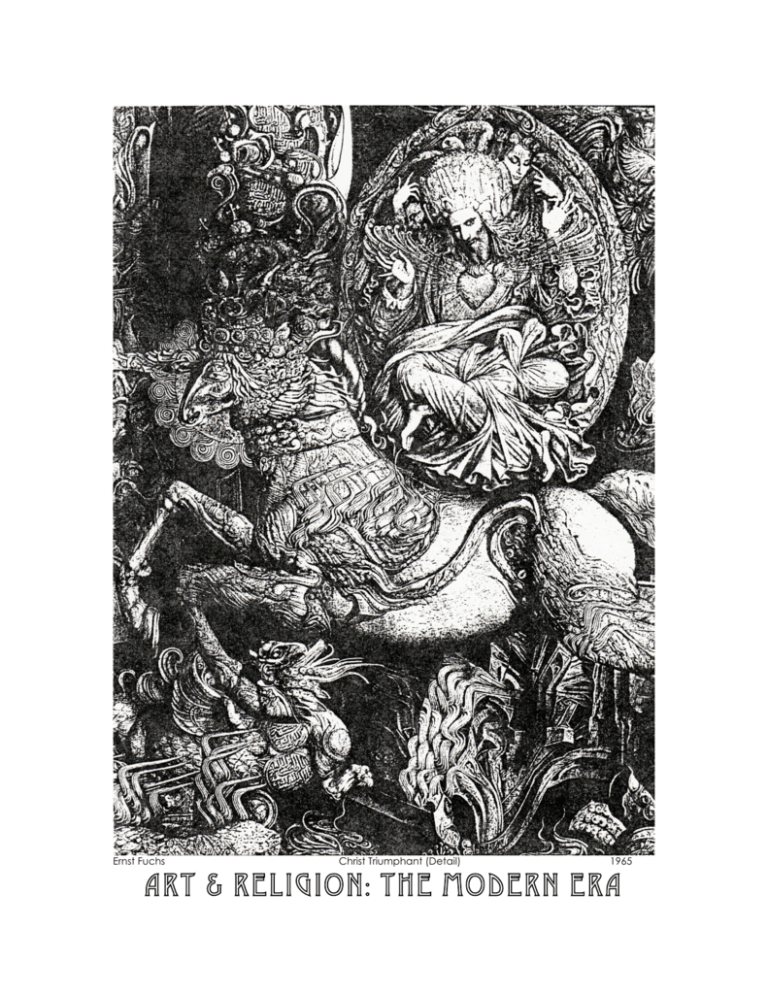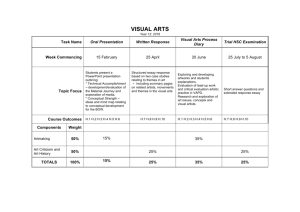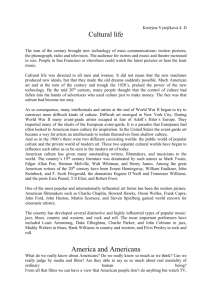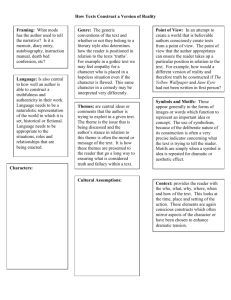ART & RELIGION: THE MODERN ERA
advertisement

Ernst Fuchs Christ Triumphant (Detail) 1965 ART & RELIGION: THE MODERN ERA ART & RELIGION: THE MODERN ERA RAHS 4305 SPRING 2013 DSPT Rm. 1 Professor Michael Morris, O.P. This course will explore the radical transformations made in western religious art from the French Revolution to the middle of the twentieth century in both Europe and America. It will examine how Catholic and Protestant expressions of faith fluctuated between a nostalgic view of the past and daring futuristic innovations. It will explain why artistic brotherhoods like the Nazarenes, the Pre-Raphaelites, and the Nabis attempted to renew and reform religious imagery and how men and women sought the Divine in a myriad of movements: from Gothic Horror to the Romantic Sublime, from Realism and Surrealism to Symbolism and Abstraction. Emphasis is on art and architecture with references to dance, theater, literature and film. Weekly lectures with visuals will be followed by class discussion. Evidence of student learning will upon class participation, frequent quizzes, a research paper, and an optional art project. COURSE OBJECTIVES & GOALS In a course that incorporates slide lectures, readings, creative projects, class discussion, and film, the student will gain a foundational knowledge of Modern Religious Art and how spiritual sensibilities survived, adapted, and evolved in the modern era. Lectures in this class are based on important themes that have emerged in the art and religion of the last two centuries. Quizzes, discussion, creative projects, and a paper will measure the student’s performance in class. Regular attendance is required. The purpose of this class is to not only to inform but also to engage the student in a learning process that is both challenging and enjoyable. It aims to chart the trajectory of religious culture in the west, from its modernist roots to the full flower of post-modernism today. READINGS & Films Specific readings are selected for most of the themed lectures presented in class. Students are expected to come prepared for class by having read the assigned material in the Class Reader. In the first week of class the Reader will be available for purchase at Vick/Copy located at 1879 Euclid Avenue, Berkeley, CA 94709. Phone: (510) 549-COPY (2679) As listed in the Syllabus/Bibliography, there are further suggested readings that are recommended but not required for each lecture theme. These suggested readings can be helpful when a student is looking for a topic for the final paper, and they can also illuminate weekly class discussions. Updates on the Bibliography will be featured during the thematic lectures, as well as pertinent exhibitions and films that coincide and amplify these themes. Films especially enable a student to capture the mood of the topics presented and discussed. Occasionally a film, or film clips, will be shown in class but a list of suggested films will accompany the list of suggested readings from which a student can choose items for greater edification. Student evaluation Besides attendance, a student will be judged on class participation in the topical discussions planned at the end of the thematic lecture. Students will take turns leading the discussions in the style of a seminar. This will constitute 1/4 of the grade. Occasional quizzes will be given throughout the semester, based on the lectures given in class. The quizzes will concentrate on terms, people, and ideas expressed and illustrated in the lectures. The quizzes will constitute another 1/4 of the student’s grade. A creative project will be asked of the student in lieu of a midterm. What this constitutes will be announced by the instructor well before Reading Week and be presented by the student in the first class session after Reading Week. This presentation will count for another ¼ of the grade. Lectures in this class are based on important themes that emerge in art and religion in the modern era. For the final ¼ of the student’s grade a typewritten paper of 20 pages will be submitted at the end of the semester. The paper will be a formal research report on some figure, movement, or work of art that falls within the religious scope of this class. Consult with the professor in choosing a topic for your final paper. SYLLABUS/BIBLIOGRAPHY An Outline of weekly topics for lecture and discussion I. REVOLUTION ARTISTS DISCUSSED: Tiepolo, Canoletto, Watteau, Vigee-Lebrun, Boucher, Fragonard, David, Ingres, Gros, Boullee, Goethe, Canova, and Madame Toussaud. THEMES: The artist as a revolutionary, The Morality of Style, The artist as a tool for politicians, The artist as an agent of pleasure, The artist as a propagandist. READER: Michael Burleigh, Earthly Powers, 23-111 SUGGESTED READING: Jean Starobinski, 1789: The Emblems of Reason; Walter Friedlander, David to Delacroix; Robert Rosenbloom, Transformations in 18th century art; Hugh Honour, Neo-Classicism FILMS: A Tale of Two Cities (1935); Marie Antoinette (1938, 2006); The Affair of the Necklace (2001); Danton (1983); Napoleon (1927) II. BACK TO THE FUTURE ARTISTS DISCUSSED: Pugin, Winklemann, Burges, Flandrin, King Ludwig II, Viollet-le-Duc, William Morris & Co., Flaxman, Isadora Duncan, Albert Speer, Leni Riefenstahl. THEMES: Totalitarian Architecture, Architecture and Morality, Contemporary Goth Phenomena, Fantasy Heroism, Romanticism READER: Augustus Welby Pugin, Contrasts, 1-58 Edmund Burke, A Philosophical Enquiry into the Origin of Our Ideas of the Sublime and the Beautiful, 55-87 Michael Alexander, Medievalism, 65-104 SUGGESTED READING: Kenneth Clark, The Gothic Revival; Terence Davis, The Gothic Taste; Phoebe Poole, Pugin; Mario Praz, Neo-Classicism, Cordula Grewe, Painting the Sacred in the Age of Romanticism FILMS: Darkon (2007); Gothic (1986); The Architecture of Doom (1989); The Occult History of the Third Reich (1999); Isadora (1968); Ludwig (1972) III. The Cult of the Painter Monk ARTISTS DISCUSSED: Walpole, Beckford, the Nazarenes, Rossetti, the PreRaphaelite Brotherhood, William Morris and Burne-Jones, La Societe de S. Jean, Beuron Abbey Art Theory, Eric Gill. THEMES: Brotherhoods of Artists, New Christian Movements in Art READER: Lorenz Eitner, Christian Revival [Sources and Documents Series], 19-39; Michael Alexander, Medievalism, 127-164 SUGGESTED READING: Michael Morris, Cowled Creatures: The image of the Monk in Georgian and Victorian England; William Holman Hunt, The Pre-Raphaelite Brotherhood and Pre-Raphaelitism; Keith Andrews, The Nazarenes. Also, http://www.films.ie/book-267834-Pre_Raphaelites.html IV. A New Protestant Aesthetic: SACRED LANDSCAPE/SUBLIME NATURE ARTISTS DISCUSSED: Cole, Friedrich, Runge, Palmer, Martin, Hudson River Valley Artists, The Luminists, Thomas Kinkade, Christo, Contemporary Earthwork Artists THEMES: America as the New Eden, the Gaia Movement, Global Philosophies, Art Nouveau, American Idealism, Planned Communities of the Future, Sustainable Farming. READER: Simon Schama, Landscape and Memory, 185-242 SUGGESTED READING: Helmut Borsch-Supan, Caspar David Friedrich; Rudolph M. Bisanz, Phillipp Otto Runge; Christopher Johnstone, John Martin; John Wilmerding, American Light: The Luminist Movement; Gene Veith et alia, Painters of Faith FILMS: Into the Wild (2007); Grizzly Man (2005); The Peaceable Kingdom (2004); Andy Goldsworthy’s Rivers and Tides (2004) V. The Art Of Morality ARTISTS DISCUSSED: Hogarth, Greuze, Chardin, the English School, Frank Capra and Hollywood THEMES: Art that teaches Morality, Sentimentality in Art and Film, Censorship and the Hollywood Production Code READER: Alexander, Medievalism, “The Working Men & Common Good” SUGGESTED READING: Ronald Paulson, Hogarth, His Life, Art, and Times; Innes & Gustav Herdan (transl.) The World of Hogarth: Lichtenberg’s Commentaries on Hogarth’s Engravings; Graham Reynolds, Painters of the Victorian Scene; John Hadfield, Every Picture Tells a Story; Christopher Wood, Victorian Panorama; Gabriel Weisberg, The Realist Tradition 18301900 Films: Great Expectations (1946); Vanity Fair (2004); Becoming Jane (2007); It’s a Wonderful Life (1946); The Run of the Country (1995) VI. THE MODERN CHRIST AND THE ALTER CHRISTUS ARTISTS DISCUSSED: J-J Tissot, Anna Catherine Emmerich, the PreRaphaelites, William Holman Hunt, Sallman, F. Holland Day, Cecil B. DeMille, Martin Scorsese, Mel Gibson. THEMES: Realism vs. Idealism in Religious Art, Artists who portray themselves as Christ, Mysticism & Art, The Role of Photography in Religion, Catholic Revivalism. READER: Michael Driskel, Representing Belief, 165-226 SUGGESTED READING: J-J Tissot, The Life of Our Savior, Jesus Christ; Anna Catherine Emmerich [as recorded by Clemens Brentano], The Dolorous Passion of Our Lord Jesus Christ; David Morgan Icons of American Protestantism: The Art of Warner Sallman; S. Brent Plate, Re-Viewing The Passion: Mel Gibson’s Film and its Critics FILMS: The Passion of the Christ (2004); The Life and Passion & Death of Our Lord Jesus Christ (1905); The Last Temptation of Christ (1988); King of Kings (1927); From the Manger to the Cross (1913) VII. Visionaries and dreamers ARTISTS DISCUSSED: Blake, West, Hicks, Allston, Rimmer, Symbolists, Richard Dadd, The Brothers Grimm, Surrealists, Fantasy Artists and Filmmakers, Walt Disney, Ernst Fuchs, Howard Finster, Outsider Artists. THEMES: Dreams and Art, the Role of Science Fiction in Art and Film, Mysticism and End Times, Visual Preaching, The Apocalyptic Sublime, Swedenborgianism, Fairy Painters, Demiurges, Religious Folk Art, the power of religious Kitsch READER: Robert Decharnes & Giles Neret, Dali, “The Mystical Manifesto,” 157-181 SUGGESTED READING: John Dillenberger, The Visual Arts and Christianity in America; Hugh Honour, Romanticism; Kenneth Clark, The Romantic Rebellion; Mario Praz, The Romantic Agony; Anthony Blunt, The Art of William Blake; Ronald Nasgaard, The Romantic North; Milton Klonsky, William Blake: The Seer and His Visions; John M. MacGregor, The Discovery of the Art of the Insane; Diane Purkiss, At the Bottom of the Garden: A Dark History of Fairies, Hobgoblins and Other Troublesome Things. FILMS: Fantasia (1940); In the Realm of the Unreal (2004); Howard Finster: Man of Visions (1983) VIII. ART AS RELIGION ARTISTS DISCUSSED: Beardsley, Wilde, Nijinsky, Diaghilev, Ida Rubenstein, Ravel, Debussy, Knopf, Gustav Moreau, Nicholas Roerich, the Symbolists, Post-Impressionists, Gauguin, Maurice Denis, the Nabis, Beuron, Buddhism and Theosophy THEMES: The Femme-Fatale in Art, Decadence, the Aesthetic Movement, Art for Art’s Sake, Dance and Biblical Themes, Homosexuality in the Arts READER: Ellis Hanson, Decadence and Catholicism, Introduction, “The Dialectic of Shame and Grace,” 1-107 SUGGESTED READING: Phillippe Jullian, The Symbolists, Dreamers of Decadence; A. M. Hammacher, Phantoms of the Imagination; Robert Goldwater, Symbolism; Malcolm Haslam, The Surrealists; Phillippe RobertsJones, Beyond Time and Place; J.-K. Huysmans Against Nature FILMS: Klimt (2006), Salome (1923), Wilde (1997), Nijinski (1980), The Bride of the Wind (2001) IX. THE ARTS AND CRAFTS MOVEMENT ARTISTS DISCUSSED: Berkeley Architecture with Bernard Maybeck and Julia Morgan, the Pre-Raphaelite second wave (William Morris & Burne Jones), Jane Burden Morris, William De Morgan, Greene & Greene, Comfort Tiffany, Jewish Arts and Crafts: Bezalel, Poiret. THEMES: Changing Design in Domestic Architecture and Fashion, The Arts & Crafts Church, Designs for Better Living. READER: Mark A. Wilson, Julia Morgan, “Houses of God” p. 68ff SUGGESTED READING: Stephen Calloway and Lynn Orr (editors) The Cult of Beauty; Sally Byrne Woodbridge, Bernard Maybeck: Visionary Architect; Mark Wilson, Bernard Maybeck: Architect of Elegance; Camilla de la Bedoyere, Tiffany Masterworks. FILMS: Desperate Romantics (2009), Topsy: William Morris (1996), Julia Morgan: A Life by Design (1990) X. Modernism ARTISTS DISCUSSED: The Bloomsbury Group, Wright, Johnson, Mondrian, Matisse, Chagall, Picasso, Rouault, Gill, Pere Couturier, Spencer, Kandinsky, Corbusier, Breuer, Expressionists, Abstract Expressionists, Manzu, Noguchi, Cocteau, Kahn, Nevelsen, Soleri, Couturier, Minimalists THEMES: Abstraction, Zen & Influences from Asia, Occultism, Modern Utopianism, Hedonism, Artists and their Signature Chapels, Making Sacred Space in Modern Times, the Role of Faith in Art, the Occult influences in Modern Art. READER: William S. Rubin, Modern Sacred Art and the Church at Assy, “Decadence and the Dominicans,” 7-30, “The Debate on Sacred Art,” 4563 SUGGESTED READING: Jean-Louis Ferrier, Art of Our Century; S. Giedion, Space, Time, and Architecture; Meyer Shapiro, Modern Art; Kenneth Baker, Minimalism; Maurice Tuchman, The Spiritual in Art: Abstract Painting 1890-1985; Stephen Schloesser, Jazz Age Catholicism: Mystic Modernism in Postwar Paris FILMS: The Fountainhead (1949); Carrington (1995); My Architect (2003) XI. transforming Influences on Modern religious art TOPICS AND FIGURES DISCUSSED: Feminism (the rise of female artists and patrons): Gertrude Stein, Dominique de Menil, Jane Blaffer Owen, Jane Dillenberger, Georgia O’Keefe, Leonora Carrington, Kathe Kollowitz, Frieda Kahlo, Louise Nevelson, Ida Rubenstein, Natacha Rambova, Judy Chicago; THEMES: African and Caribbean Influences: Africa and Modern Art, The Negro Spiritual in Music and Film, Frederick Brown, the art of Haiti; Hispanic Transformations: The Cult of Guadalupe, Shrines and Mural Painting in Urban America, Southwest Style in Church Architecture, Decoration and Liturgy. READER: Jane Dillenberger, Perceptions in the Spirit in Twentieth Century American Art SUGGESTED READING: David Bindmen (editor), The Image of the Black in Western Art volumes 3 and 4; William Rubin (ed), “Primitivism” in TwentiethCentury Art (2 vols), James Noel, The Passion of the Lord: African American Reflections; Wanda Corn, Seeing Gertrude Stein: Five Stories; Michael Morris, Madam Valentino: The Many Lives of Natacha Rambova; Holly Barnet-Sanchez, Signs from the Heart: California Chicano Murals FILMS: Salome (1923); The Green Pastures (1936); Black Orpheus (1959); Diane Keaton’s Heaven (1996) XII. Pop ART and Post-Modernism ARTISTS DISCUSSED: Graves, Graham, Segal, Longo, Claudio Bravo, Komar & Melamid, Pierre & Giles, Andy Warhol, Photo-Realism, Frank Gehry THEMES: Humor & Irony in Art, Re- or Mis- Interpreting the Past, Deconstruction. READER: Jane Dillenberger, The Religious Work of Andy Warhol, “Leonardo’s Last Supper Transformed,” 78-99 SUGGESTED READING: Charles Jenks, Post-Modernism; Carter Ratcliff, Komar and Melamid, Wheeler et alia, Michael Graves FILMS: Superstar: The Life and Times of Andy Warhol (1990); (Bill Viola) The Eye of the Heart (2005) & The Passing (2006) This Syllabus is always subject to change, additions, and subtractions when least expected. It is, like LIFE…a work in progress!







